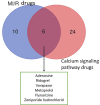Targeting Calcium Homeostasis in Myocardial Ischemia/Reperfusion Injury: An Overview of Regulatory Mechanisms and Therapeutic Reagents
- PMID: 32581817
- PMCID: PMC7296066
- DOI: 10.3389/fphar.2020.00872
Targeting Calcium Homeostasis in Myocardial Ischemia/Reperfusion Injury: An Overview of Regulatory Mechanisms and Therapeutic Reagents
Abstract
Calcium homeostasis plays an essential role in maintaining excitation-contraction coupling (ECC) in cardiomyocytes, including calcium release, recapture, and storage. Disruption of calcium homeostasis may affect heart function, leading to the development of various heart diseases. Myocardial ischemia/reperfusion (MI/R) injury may occur after revascularization, which is a treatment used in coronary heart disease. MI/R injury is a complex pathological process, and the main cause of increased mortality and disability after treatment of coronary heart disease. However, current methods and drugs for treating MI/R injury are very scarce, not ideal, and have limitations. Studies have shown that MI/R injury can cause calcium overload that can further aggravate MI/R injury. Therefore, we reviewed the effects of critical calcium pathway regulators on MI/R injury and drew an intuitive diagram of the calcium homeostasis pathway. We also summarized and analyzed calcium pathway-related or MI/R drugs under research or marketing by searching Therapeutic Target and PubMed Databases. The data analysis showed that six drugs and corresponding targets are used to treat MI/R injury and involved in calcium signaling pathways. We emphasize the relevance of further detailed investigation of MI/R injury and calcium homeostasis and the therapeutic role of calcium homeostasis in MI/R injury, which bridges basic research and clinical applications of MI/R injury.
Keywords: Therapeutic Target Database; calcium homeostasis; calcium signaling pathway; myocardial ischemia/reperfusion injury; therapeutic reagents.
Copyright © 2020 Wang, Wang, He, Sun and Sun.
Figures


Similar articles
-
Inhibition of miR-181b-5p protects cardiomyocytes against ischemia/reperfusion injury by targeting AKT3 and PI3KR3.J Cell Biochem. 2019 Dec;120(12):19647-19659. doi: 10.1002/jcb.29271. Epub 2019 Jul 11. J Cell Biochem. 2019. PMID: 31297863
-
MICU1 protects against myocardial ischemia/reperfusion injury and its control by the importer receptor Tom70.Cell Death Dis. 2017 Jul 13;8(7):e2923. doi: 10.1038/cddis.2017.280. Cell Death Dis. 2017. PMID: 28703803 Free PMC article.
-
[Relationship between calcium overload and myocardial ischemia reperfusion injury and intervention strategy of Chinese herbal medicine].Zhongguo Zhong Yao Za Zhi. 2016 Jun;41(11):2168-2173. doi: 10.4268/cjcmm20161130. Zhongguo Zhong Yao Za Zhi. 2016. PMID: 28901117 Chinese.
-
Roles and mechanisms of SUMOylation on key proteins in myocardial ischemia/reperfusion injury.J Mol Cell Cardiol. 2019 Sep;134:154-164. doi: 10.1016/j.yjmcc.2019.07.009. Epub 2019 Jul 22. J Mol Cell Cardiol. 2019. PMID: 31344368 Review.
-
The Role of Calcium Handling Mechanisms in Reperfusion Injury.Curr Pharm Des. 2018;24(34):4077-4089. doi: 10.2174/1381612825666181120155953. Curr Pharm Des. 2018. PMID: 30465493 Review.
Cited by
-
Vaspin inhibits ferroptosis: A new hope for treating myocardial ischemia-reperfusion injury.Cytojournal. 2024 Dec 13;21:64. doi: 10.25259/Cytojournal_141_2024. eCollection 2024. Cytojournal. 2024. PMID: 39917014 Free PMC article.
-
Iguratimod Alleviates Myocardial Ischemia/Reperfusion Injury Through Inhibiting Inflammatory Response Induced by Cardiac Fibroblast Pyroptosis via COX2/NLRP3 Signaling Pathway.Front Cell Dev Biol. 2021 Oct 25;9:746317. doi: 10.3389/fcell.2021.746317. eCollection 2021. Front Cell Dev Biol. 2021. PMID: 34760889 Free PMC article.
-
Is N-methylacetazolamide a possible new therapy against ischemia-reperfusion injury?Front Pharmacol. 2023 Aug 10;14:1223132. doi: 10.3389/fphar.2023.1223132. eCollection 2023. Front Pharmacol. 2023. PMID: 37637427 Free PMC article. Review.
-
The air-breathing Alaska blackfish (Dallia pectoralis) remodels ventricular Ca2+ cycling with chronic hypoxic submergence to maintain ventricular contractility.Curr Res Physiol. 2022 Jan 10;5:25-35. doi: 10.1016/j.crphys.2022.01.001. eCollection 2022. Curr Res Physiol. 2022. PMID: 35072107 Free PMC article.
-
Hypoxia-responsive zinc finger E-box-binding homeobox 2 (ZEB2) regulates a network of calcium-handling genes in the injured heart.Cardiovasc Res. 2024 Dec 4;120(15):1869-1883. doi: 10.1093/cvr/cvae163. Cardiovasc Res. 2024. PMID: 39308239 Free PMC article.
References
-
- Åström-Olsson K., Karlsson L., Mattsson Hultén L., Davidsson P., Mantovani V., Månsson C., et al. (2009). Myocardial release of FKBP12 and increased production of FKBP12.6 in ischemia and reperfusion experimental models. Biochem. Biophys. Res. Commun. 390, 1299–1304. 10.1016/j.bbrc.2009.10.140 - DOI - PubMed
Publication types
LinkOut - more resources
Full Text Sources

